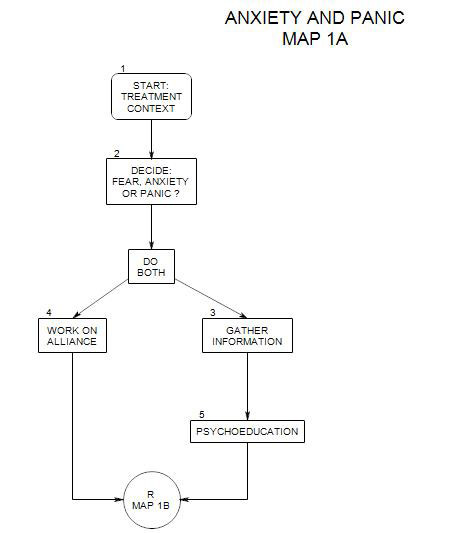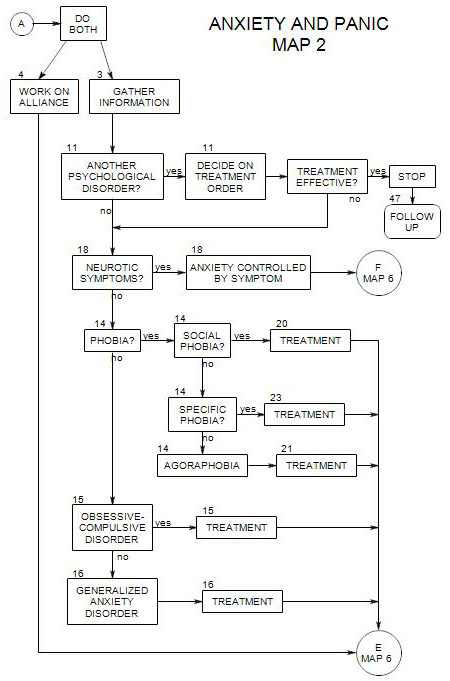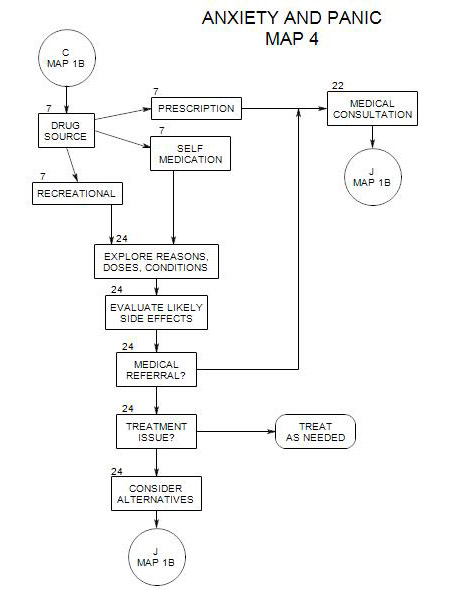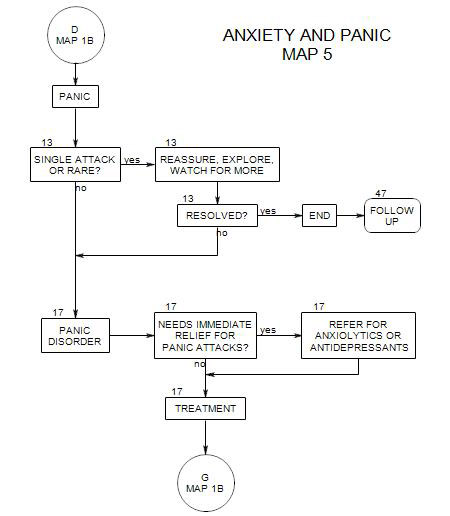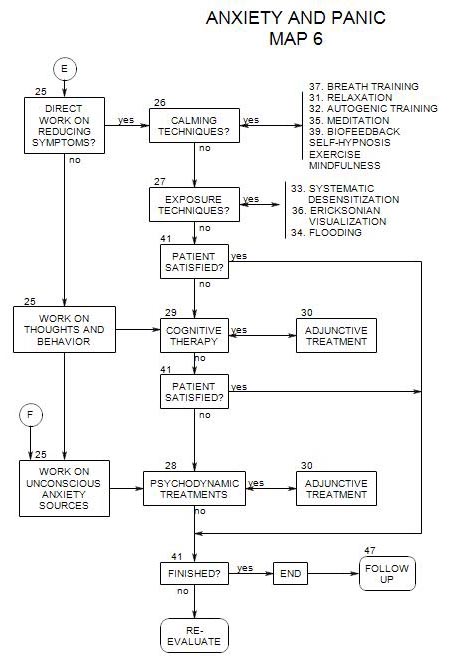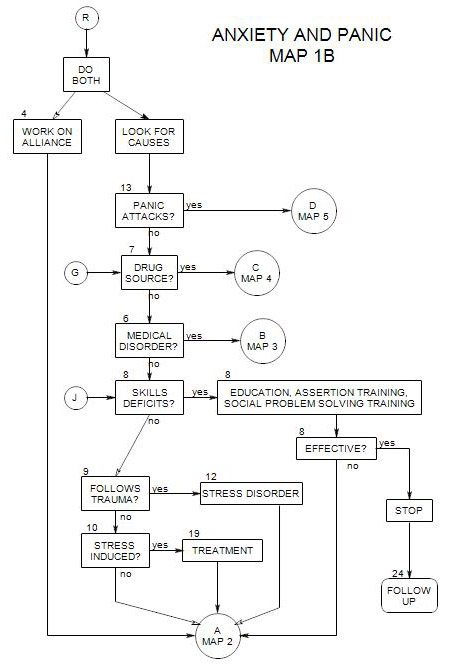
SECTIONS: 4 | 6 | 7 | 8 | 9 | 10 | 12 | 13 | 19 | 24
- Follows from Section 14 on Map 2
Treatment varies according to the severity and pervasiveness of the issue, as well as the presence of certain other conditions, as indicated below.
20a. Occasional performance anxiety
When the issue is performance anxiety in a person who is not otherwise socially phobic, and psychotherapy is unacceptable to the person, episodic relief can generally be obtained from beta blockers. See Section 38 for more.
20b. Components of Social Phobia
These include (Gruber and Heimberg, 1997, p. 248)-
- anticipatory anxiety, in which the person fears being judged, looking foolish, appearing anxious, etc.
- avoidance of the situation feared.
- loss of self-confidence and negative judgments about self.
20c. Comorbid Conditions
Before proceeding with treatment, you should determine whether the person also suffers from another psychological disorder, such as-
- Depression
- Panic disorder
- Alcohol or drug misuse
- Obsessive-compulsive symptoms
- Bulimia
- Anorexia
If one of these is a possible diagnosis,
- it may be necessary to treat the other disorder first [eg: panic attacks or alcohol misuse], or
- the other issues may limit the person’s ability to use either psychodynamic therapy or some medications, or
- you may need to treat both disorders concurrently.
Depression, for example, may be either a source of a person’s social isolation and subsequent awkwardness and avoidance, or it may be a consequence of the inability to interact effectively with others. Similarly, alcohol misuse may be a cause of social isolation and eventual social phobia; it may also be an attempt to self-medicate for social phobia (Marshall, 1996, p. 128).
20d. List of Fears
If you haven’t already done so, it is a good idea to get a list of the situations, objects, events, etc., that the person fears. If you move on to symptom reduction therapy, you can establish a hierarchy starting with the list. If you use a psychodynamic approach, the list will give you an idea of the issues to be explored. (Gruber and Heimberg, 1997, p. 251)
Examination of the list can also help you group the items as a way either to explore their history or meaning or to select starting points for anxiety reduction. If the latter, you can also obtain ratings of the subjective index of discomfort for each of the items (Gruber and Heimberg, 1997, p. 251). This can then lead to establishment of a hierarchy of fears and systematic desensitization [Section 33].
20e. Symptom Reduction Therapy
Some very specific social phobias can be treated behaviorally, through exposure techniques [Section 27], training in social skills [ Section 8 ], or relaxation [ Section 31 ].
Cognitive and behavioral treatment are usually recommended (Marshall, 1996, p. 129), to deal with psychological symptoms such as-
- anticipation of negative events.
- fear of doing something that will lead to rejection or censure.
- sensitivity to judgments by others.
- fear of loss of control in social settings.
- shame about being seen as fearful, shy or antisocial.
- imagining oneself to be strange and unique.
Many therapists believe (Marshall, 1996, p. 129; Gruber and Heimberg, 1997, pp. 245-279) that confrontations can be carried out more effectively in group settings. Gruber and Heimberg offer a treatment package that includes group cognitive restructuring, imaginal desensitization, and homework.
20f. Issues for Psychodynamic Therapy
You might keep the following in mind as possible antecedents to be addressed in the context of psychodynamic treatment:
- a history of severe teasing in childhood.
- a precipitating trauma.
- a history of observing others being ridiculed or humiliated or being anxious in a social situation.
- a family with members showing social avoidant behavior.
- early behavioral inhibition.
- a sense of lack of control.
- repeated social defeat by family, neighborhood or peers.
- the idea of social rejection.
- childhood separation experiences or fears.
Current cues for a social phobic reaction could include-
- anger from others, or anticipation of it.
- dominance behavior from another person.
Current cues have conscious and unconscious meanings and historical antecedents that can be effectively explored.
20g. Choice of Treatment
As with other fears, a key element in treatment is exposure to the phobic object or situation in such a way as to reduce the strength of response. This is handled differently by different treatment approaches. This section organizes the approaches, Section 25 deals with choice of approach.
Behavioral exposure techniques place the person in the feared situation and keep him/her there until the fear subsides [See Section 27].
Cognitive treatments deal with the conscious thinking patterns that support the phobia [See Section 29].
Psychodynamic therapies work with the web of meanings, conscious and unconscious, that underlie the phobia [See Section 28].
Treatment can also be divided according to the treatment setting – whether individual, couple, family or group.
Individual therapy can be tailored to the fears of the person whether it by arriving at that person’s unique set of fears and their relative saliency in behavioral treatment, dealing with that person’s unique set of cognitive distortions, or uncovering that person’s unique history and unconscious meanings.
Couple treatment
Family therapy
Group treatment has the advantages of itself constituting a kind of in vivo exposure, offering group support and observational learning, and recognition that the person’s issues are not unique and weird. [Gruber and Heimberg,254]
20h. Adjunctive Treatment
If the person’s only concern is episodic relief for circumscribed situations and he/she is not an active alcoholic, then benzodiazepines may be a reasonable solution. See Section 38 for more on this.
For social phobia and panic disorder, if the person is not an active alcoholic, benzodiazepines can be immediately effective in symptom relief. However, they present a risk of dependency if used continually for two weeks or more.
For a combination of social phobia and depression, SSRI’s have been found to be helpful, including Prozac [fluoxetine], Paxil [paroxetine], and Zoloft [sertraline]. Effexor an SNRI, also targets norepinephrine and has a potential dual effectiveness. However, the effectiveness of any SSRI or SNRI may be reduced by alcohol use.
20i. Formal Diagnoses
300.23: Social Phobia is acceptable to insurance companies.
301.82: Avoidant Personality may not be acceptable, even though the diagnostic symptoms are similar to generalized social phobia
